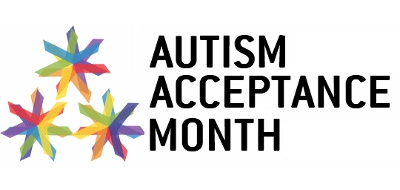Disclaimer: The following article uses identity-first language. To read about why the Autistic community prefers identity-first language, click here. This information is adapted from the Autistic Self Advocacy Network’s resource “What is Autism?” for Autism Acceptance Month.
What is autism?
Autism is a developmental disability which affects language and communication, sensory processing and motor skills, cognition, and social interaction.
What does that mean?
Autism develops in the brain from birth, and usually begins to be noticeable around age 2. Autism is essentially just another way of seeing the world–however, it is disabling because the following characteristics can make it difficult to function in modern society.
Characteristics:
1. Sensory processing
Autism causes senses (sight, touch, smell, etc.) to be processed differently. Senses can be more intense, and more difficult to understand and manage–or less intense, and harder to use. An autistic person might be more sensitive to loud noises or bright lights, or not be able to follow two people talking at once. Sensitivity to certain smells or textures is also common. They might not like being touched, or might really like being squeezed in a tight hug. Autism is a spectrum and therefore manifests in many different ways. Difficulties with sensory processing cause many autistic people to engage in repetitive movements. These repetitive motions–rocking back and forth, flapping hands, twirling, etc.–are known as motor stereotypies, or self-stimulatory behavior (“stimming”). Stimming helps to soothe and calm, regulate the senses, and process the environment.
2. Language & communication
15-20% of people with autism do not develop oral speech. They instead use augmentative and alternative communication methods (AAC) such as typing, sign language, picture exchange, pointing, and other methods to communicate.
Oftentimes even Autistic people who can speak also need to use some of these communication methods in their everyday life, but most do develop the ability to speak. Some develop speech later in life; some develop speech, but primarily communicate by repeating things other people have said. This is called echolalia. Some have fluent oral speech. The language might be scripted, verbose, literal, circumspect, or otherwise different. They might have a difficult time with grammar, pragmatics, or social communication.
They can also have a hard time with receptive communication, or understanding what another person is saying. Especially if someone speaking is using language abstractly or metaphorically, or using a lot of words, as many people with autism tend to use or understand language very literally.
3. Cognition
Autistic people might be described as “rigid,” “inflexible,” or black-and-white thinkers. They may not be comfortable with ambiguity, change, or lack of structure. They may seem particularly ritualistic, compulsive, or detail-oriented. They may have problems with executive functioning–the ability to stay on task, pay attention, switch between tasks, initiate new tasks, use our memory effectively, and control impulses.
Autistic people often have difficulties with sequencing the parts of, or the steps in, tasks, ideas, sentences, words, or even physical movements. This can make planning projects or daily tasks difficult for us, or make it harder to initiate actions or communicate in ways other people can understand.
Some also have a diagnosis of intellectual disability or a learning disability. Autism is not the same as an intellectual or learning disability, but some people have both. Research is finding that the number of people who are both autistic and intellectually disabled is much lower than it used to be thought.
Many traditional IQ tests do not accurately reflect an autistic person’s ability, because the communication impairments and other autistic features interfere with assessment.
A common characteristic of autism is hyper-focus, or “perseveration”–intense focus on one subject, special interest, or part of a larger system or object. This can be anxiety-producing (for example, perseverating on whether or not you remembered to turn the stove off,) incredibly useful (for example, being obsessed with astronomy might lead to a very successful career studying their interest,) or just fun or relaxing (for example, stamp collecting.)
4. Motor skills
Many autistic people have delays in fine or gross motor skills or coordination. Sometimes this leads to an additional diagnosis of dyspraxia or apraxia.
For some autistic people, this means that oral speech is impossible, or that pointing, shoe tying, initiating movement, and other things are difficult or impossible.
5. Social behaviors
Much of communication in general is non-verbal. Autistic people may have a difficult time reading other people’s body language, tone, and nonverbal cues. Autistic people often have unique or eccentric ways of communicating and expressing themselves non-verbally. This can also make it difficult to interpret the non-verbal communication of others.
Many autistic people find eye contact uncomfortable or may forget to or be unable to make it at times when it may be socially expected. The ability to make eye contact can vary a lot depending on the situation, the people involved, and the amount of stress that we may be under.
Perspective-taking is an important part of social interaction. Many people rely on their own intuitions of how they would behave when trying to take the perspectives of others. Autistic people, due to differences in cognition, communication, sensory processing, and motor planning, tend to have very different perspectives and reactions than many people. This can make perspective-taking and social interaction more complicated. Because of all the differences in sensory processing, communication, language use, nonverbal communication, and cognition, it may be very difficult for autistic people to make or keep friends, or engage in large amounts of social interaction.

